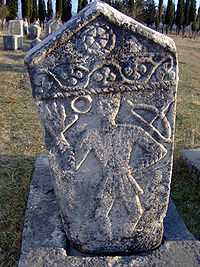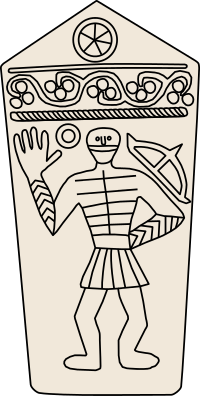Stećak


Stećak ([stetɕak]; plural: Stećci [stetɕtsi]) is the name for monumental medieval tombstones that lie scattered across Bosnia and Herzegovina, and the border parts of Croatia, Montenegro and Serbia, although almost exclusively following the borders of the medieval Bosnian Kingdom. An estimated 60,000 are found within the borders of modern Bosnia and Herzegovina and the rest of 10,000 are found in what are today Croatia, Serbia, and Montenegro.[1] Appearing in the 11th century, the tombstones reached their peak in the 14th and 15th century, before disappearing during the Ottoman occupation. They were a common tradition amongst Bosnian Church, Catholic and Orthodox followers.[2] The epitaphs on them are written in Bosnian Cyrillic alphabet ("Bosančica" [bosaŋtʃitsa]) and the alphabets belonging to the Bosnian church and medieval Kingdom of Bosnia. The largest collection of these tombstones is named Radimlja, after a local river, and is located 3 km west of Stolac in Bosnia and Herzegovina.
Stećci have been nominated to the UNESCO World Heritage List as Joint Cultural Heritage by the four countries in 2009.[1]
Etymology
The word itself is a contracted form of the older word stojećak, which is derived from the verb stajati (v. stand). It literally means "the standing thing".
Characteristics
Their most remarkable feature is their decorative motifs, many of which remain enigmatic to this day. spirals, arcades, rosettes, vine leaves and grapes, suns and crescent moons are among the images that appear. Figural motifs include processions of deer, dancing the kolo, hunting and, most famously, the image of the man with his right hand raised, perhaps in a gesture of fealty.
History
Although its origins are within the Bosnian Church, all evidence points to the fact that Stećci were erected in due time by adherents of the Orthodox, Catholic and Islamic faith alike. Today many Stećci are displayed in the garden of the National Museum of Bosnia and Herzegovina in Sarajevo.
On 2 November 2009, the government ministers of Bosnia and Herzegovina, Croatia, Serbia and Montenegro agreed to nominate the Stećci as their shared cultural heritage to the UN World Heritage List.[1]
Controversies
Some historians have argued that the Bosnian Church was related to Bogomils of First Bulgarian Empire or other dualist groups. Others have asserted that the church was actually founded by Franciscan monks from the Catholic Church.[3] However, Marian Wenzel, the world's leading authority on the art and artifacts of medieval Bosnia and Herzegovina,[4] concluded that the stećci tombstones were a common tradition amongst Catholic, Orthodox and Bosnian Church followers alike.[2] Wenzel's conclusion supported other historians' claims that the Stećci reflect a regional (Bosnian) cultural phenomenon rather than belonging to a particular faith.[5]
Famous Stećci
- The oldest Stećak is that of Grdeša, a 12th-century Duke of Trebinje.
- The medieval Mramorje necropolis in Serbia, Monument of Culture of Exceptional Importance contains large number of Stećak tombs.[6]
- Vlatko Vuković's grave lies marked near the village of Boljuni near Stolac, Bosnia and Herzegovina, from late 14th century. Inscription on the grave was written in Bosnian Cyrillic Script (bosančica or bosanica) in ikavian accent.[7]
- The most famous and decorated stećak is from Zgošća near Kakanj in Bosnia and Herzegovina, from 15th century. Although it has no engraved writing, since it was immaculately decorated, it is suggested that it belonged to Ban Stjepan II Kotromanić.
- Some of the best preserved stećak can be find in area of Srebrenica municipality, in this place there are around 800 stećci.
Gallery
-
Radimlja necropolis, Bosnia and Herzegovina
-

Umoljani, Bosnia and Herzegovina
-

Dugopolje, Bosnia and Herzegovina
-
Risovac, Bosnia and Herzegovina
-
Mramorje, Serbia
-
Imotski, Croatia
See also
References
- ↑ 1.0 1.1 1.2 Sito-Sucic, Daria (November 2, 2009). "Balkans to nominate medieval tombstones to U.N. list". Reuters.
- ↑ 2.0 2.1 Walasek, Helen. "Marian Wenzel 18 December 1932 - 6 January 2002". Bosnian Institute.
- ↑ Fine, John. The Bosnian Church: Its Place in State and Society from the Thirteenth to the Fifteenth Century: A New Interpretation. London: SAQI, The Bosnian Institute, 2007. ISBN 0-86356-503-4
- ↑ Brook, Anthea (March 5, 2002). "Marian Wenzel". The Guardian (London). Retrieved May 24, 2010.
- ↑ Fine, John V. A. (1991). The Late Medieval Balkans: A Critical Survey from the Late Twelfth Century to the Ottoman Conquest. University of Michigan Press. p. 486. ISBN 0-472-08149-7.
- ↑ 6.0 6.1 Monuments of Culture in Serbia: Некропола стећака (SANU) (Serbian) (English)
- ↑ Šimić, Marinka. "JEZIK BOLJUNSKIH NATPISA" (PDF). Staroslavenski institut.
External links
| Wikimedia Commons has media related to Stećci. |




